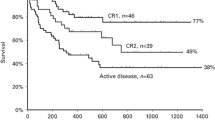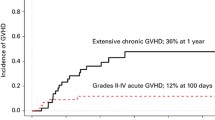Abstract
This study aimed to assess the safety and efficacy of using high dose melphalan and etoposide followed by autologous, non-cryopreserved marrow rescue in advanced Hodgkin's disease (HD). Seventeen patients with poor risk Hodgkin's disease from a single centre underwent autologous bone marrow transplant (ABMT) using high dose melphalan and etopside conditioning. Two patients had primary progressive resistant disease (PD), two were in fourth relapse, six in second or third complete remission (CR), one patient had good partial response (GPR) (> 75% reduction in initial bulk) to primary therapy and six were in first complete remission. The patients transplanted in first CR all has a Scotland and Newcastle Lymphoma Group (SNLG) Prognostic Index (Proctor et al., 1991) which indicated they were in a poor risk prognostic group. Melphalan and etoposide both have a short half life enabling ABMT to be accomplished using unmanipulated marrow stored at 4 degrees C. The marrow was returned to the patient within 56 h of harvest. Complete haematological reconstitution occurred in 16/17 patients, the rate of engraftment reflecting the amount of previous chemotherapy. One patient died of progressive Hodgkin's disease before full engraftment could occur. In patients autografted in first remission, the median number of days with neutropenia (< 0.5 x 10(9) l-1 neutrophils) was 19 (range 9-33) and, in those in subsequent remission, 27 days (range 18-36). The median number of days to 50 x 10(9) l-1 platelets in the same groups were 29 (21-80) and 50 (41-74) respectively. The number of days in hospital post transplant in both groups was similar; median 22 (15-27) and 23 (17-37) respectively. There were no procedural deaths and none of the patients transplanted in first, second or third CR have relapsed (median follow up 21 months). The two patients transplanted with progressive disease showed only temporary responses. The two patients transplanted in fourth relapse went into CR; one is still alive and in CR 15 months post transplant, but the other relapsed 18 months post transplant. This form of intensification therapy with marrow rescue has been shown to be effective and of low toxicity and now forms part of a randomised controlled trial in poor risk Hodgkin's patients as identified by the SNLG index (Proctor et al., 1992).
Similar content being viewed by others
Author information
Authors and Affiliations
Consortia
Rights and permissions
About this article
Cite this article
Taylor, P., Jackson, G., Lennard, A. et al. Autologous transplantation in poor risk Hodgkin's disease using high dose melphalan/etoposide conditioning with non-cryopreserved marrow rescue. Br J Cancer 67, 383–387 (1993). https://doi.org/10.1038/bjc.1993.70
Issue Date:
DOI: https://doi.org/10.1038/bjc.1993.70
- Springer Nature Limited
This article is cited by
-
Cryopreserved versus non-cryopreserved stem cell autografts in multiple myeloma a restrospective cohort study
Bone Marrow Transplantation (2022)
-
LACE-conditioned autologous stem cell transplantation for relapsed or refractory Hodgkin's lymphoma: treatment outcome and risk factor analysis in 67 patients from a single centre
Bone Marrow Transplantation (2007)
-
Comparative pharmacokinetic study of high-dose etoposide and etoposide phosphate in patients with lymphoid malignancy receiving autologous stem cell transplantation
Bone Marrow Transplantation (2003)




